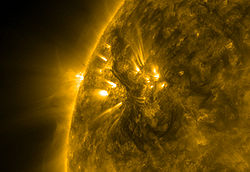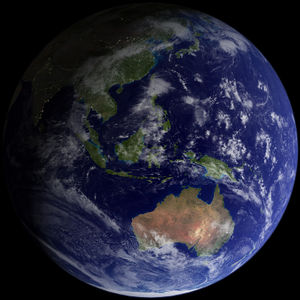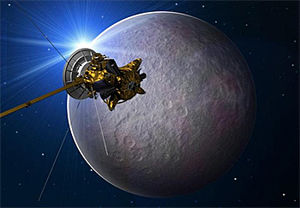Sol
| “ | I know that humans will colonize the solar system and one day go beyond. | ” |
| —Mike Griffin, former NASA Administrator | ||
| Sol | |
 Dark Filament of the Sun, wider than 40 times the diameter of Earth | |
| Stellar characteristics | |
|---|---|
| Constellation | n/a |
| Right ascension (Epoch J2000) | 0 |
| Declination (Epoch J2000) | 0 |
| Spectral type | G2 V |
| Distance from Sol | 0 ly |
| Other designations | The Sun |
| Planets | Planets: Mercury, Venus, Earth, Mars, Jupiter, Saturn, Uranus, Neptune Dwarf Planets: Ceres, Pluto, Haumea, Makemake, Eris |
Sol is not like most stars in the Solar neighborhood or the entire Milky Way galaxy. While most stars have stellar companions, Sol is a single star, which is fortunate for Earth life because stable planetary orbits like the Earth's are far more likely around single stars. In addition, Sol is among the most massive 10 percent of stars in its neighborhood, which means that it is hotter and brighter than most stars in its area of the Milky Way. Finally, Sol has about 50 percent more heavy elements than other stars of its age and type, but only about a third of their variation in brightness, which is also fortunate because heavy elements are essential to make planets like Earth and large stellar flare-ups can harm planetary life with hard radiation.
Sol is a yellow-orange, main sequence dwarf star, of type G2 V. Born in our Milky Way galaxy's disk about 4.6 billion years ago, it may shine as a normal "dwarf" star for another five billion years. It is relatively rich in elements heavier than hydrogen created by primordial supernovas, and so is called a high metallicity, "Population I" star.
Contents
[hide]Known Places around Sol
Sol has eight planets, five dwarf planets, and an unknown but large number of small solar system bodies in orbit around it. One of the dwarf planets and many of the small solar system bodies are found in an asteroid belt, while the other four known dwarf planets and uncounted small solar system bodies are found in a Kupier Belt and an Oort cloud. Some of the small solar system bodies are found as satellites (or moons) of many of the other solar system objects.
The Solar system is probably the best known and explored place in Fenspace.[1]
Planets
Mercury
Mercury is a hot, rocky planet that orbits Sol at about 0.4 Astronomical Units, or AU, with a period of about 88 days. It is 40 percent larger than Luna but smaller than both Ganymede and Titan.
Mercury has no natural satellites.
Venus
Venus is a rocky planet with a thick atmosphere. It orbits Sol at about 0.7 AU with a period of about 227 Earth days. A Venusian 'Day' is approximately 243 Earth days.
Venus has no natural moons.
Earth
Earth is a rocky, water covered planet. It orbits Sol at a distance of 1 AU.[2] Earth may or may not be home to intelligent life.
Earth has one natural satellite, Luna, and an unknown but large number of artificial satellites, including the International Space Station and over two dozen stations in cislunar space.
Mars
Mars is the last of the rocky inner planets in the Solar system. It orbits at about 1.5 AU with a period of 1.9 Earth years.
Mars has two natural satellites, Phobos and Deimos, and at least two artificial satellites, Starbase One and Odyssey.
Jupiter
The largest planet orbiting Sol, Jupiter is a gas giant with 63 known natural moons, including the "Galilean moons" Io, Europa, Ganymede, and Callisto.
Jupiter's orbital distance is 5.2 AU and its period is 1.9 Earth years.
Saturn
Saturn is a gas giant with an extensive ring system. It has an orbital distance of 9.5 AU and a period of 29.5 Earth years.
Saturn has at least 62 natural satellites, including Titan (the only natural satellite with a substantial natural atmosphere in the Solar system), Rhea (which has a thin atmosphere that contains oxygen, and may have natural satellites of its own), and Mimas. It also has an artificial satellite, Cassini–Huygens.
Uranus
The third gas giant orbiting Sol, Uranus has an orbital distance of 19.2 AU and a period of 84.0 Earth years.
Uranus has at least 27 natural moons.
Neptune
Neptune is the farthest major solar system planet from Sol, and the last gas giant in the Solar system. Its orbital distance varies between 29.7 and 30.4 AU from Sol, and its orbital period is 84.3 Earth years.
Neptune has 13 known natural satellites, including Triton and Nereid.
Dwarf Planets
Ceres
1 Ceres was the first dwarf planet to be discovered, the smallest known dwarf planet, and the only dwarf planet inside the orbit of Jupiter. It has an orbital period of 4.6 years and an orbital distance that varies between 2.55 and 2.99 AU.
Pluto
134340 Pluto is the second-largest known dwarf planet in the Solar System. It has an orbital period of 248 years and an orbital distance that varies between 29.7 and 49.3 AU. It has at least three natural satellites, Charon, Nix, and Hydra, and one artificial satellite, Hades Station.
Haumea
136108 Haumea is a dwarf planet in the Kuiper belt, with a mass one-third that of Pluto. It has an orbital period of 283 years and an orbital distance that varies between 34.7 and 51.5 AU. It has at least two natural moons, 136108 Haumea I Hiʻiaka and 136108 Haumea II Namaka
Makemake
136472 Makemake is the third-largest known dwarf planet in the Solar System. Found in the Kuiper belt, it has an orbital period of 310 years and an orbital distance that varies between 38.5 and 53.1 AU. It has no known natural satellites.
Eris
136199 Eris, the largest known dwarf planet, is on average farther away from Sol than any other Solar system planet or known dwarf planet. It has an orbital period of 577 years and an orbital distance that varies between 37.8 and 97.6 AU. It has one known moon, Dysnomia.
Small Solar System Bodies
There are hundreds of thousands of known small solar system bodies, over 15,000 of which have been named. Many of these bodies are found in the Main Belt, but the majority are found elsewhere in the Solar system.
Notes
Some scientific data was sourced from SolStation.com and Wikipedia.
- Jump up ↑ For obvious reasons
- Jump up ↑ In fact, Earth's orbital distance is the original definition of the Astronomical Unit.
| ||

